Shalmali, Silk Cotton Tree (Salmalia malabarica)
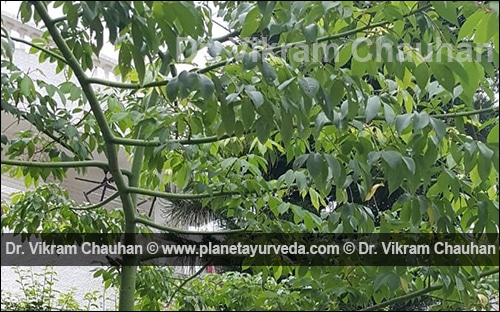
Description of plant
Shalmali tree grows in tropical humid conditions and reaches height up to 20 meters and old trees reach maximum height of 60mts in wet tropical weathers. This tree is known as king of forest because of its beautiful flowers and massive size. This plant contains deciduous leaves and straight and stout trunk with light grey color and it bears hard, sharp and conical thorns. Semal tree bears red colored beautiful flowers and flowers are cup-shaped. Flowers of this plant are solitary or in cluster near the end of branches. Flowers are about 6-7inch long and 7 inches broad.
Flowers of this plant are made up of five red or scarlet, satiny and sometimes white colored petals. Flowering season of this plant is during January to march. Ball like fruits of this tree appear in March and April and fruits are filled with cotton like stuff. Immature fruits are light green in color and after ripening color changes to dark brown. Villagers gather the fruits of shalmali tree and take kapok i.e. cotton like substance.
General description
Red silk cotton tree, Indian kapok tree, shalmali, semal, simal, shemul are various names of Salmalia Malabarica. In Indian tradition it has one common place among the five sacred trees. In ayurvedic medicinal system this plant is used for its various medicinal properties like – aphrodisiac, astringent, stimulant, tonic, anti-diarrheal, anti-dysentery, anti-microbial and anti-pyretic. Nature has served every part of this plant with medicinal properties. Different parts of this plant are used for the treatment of fever, smallpox, leprosy and to cure rheumatism. Roots of this plant are stimulant, tonic, and aphrodisiac and are used to cure impotency. Fruits are stimulant, expectorant, diuretic, used for chronic inflammation and calculus. In males this beneficial herb is used to cure nocturnal emission and various disorders related to semen.
According to vagbhata shalmali is used through nasal routes to cure body aches and stiffness.
Stout trunk of this tree is useful for timber; soft wood of this plant is very useful. This tree is very famous for manufacturing purposes such as – moulds, matchbox and sticks, plywood and scabbards. Cotton like substace obtained from fruits is used to stuff sofas, quilts and pillows.
Whole plant of shalmali contains betasistosterol and glucosides. Root bark contains lupeol and hydroxycadalene. Beautiful flowers of this plant contain maximum composition of hentricontane and hentriacontanol. Chemical compounds present in seed oil are arachidic acid, linoleic acid, myristic acid, oleic acid and palmitic acid. Seeds contain carotenes, n-hexacosanol, ethylgallate and tocopherols and gum of this plant is rich in gallic acid, tannic acid, l-arbinos, D-galactose, D-galacturonic and D- galactopyranose.
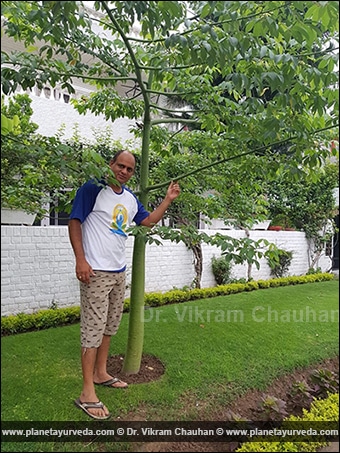
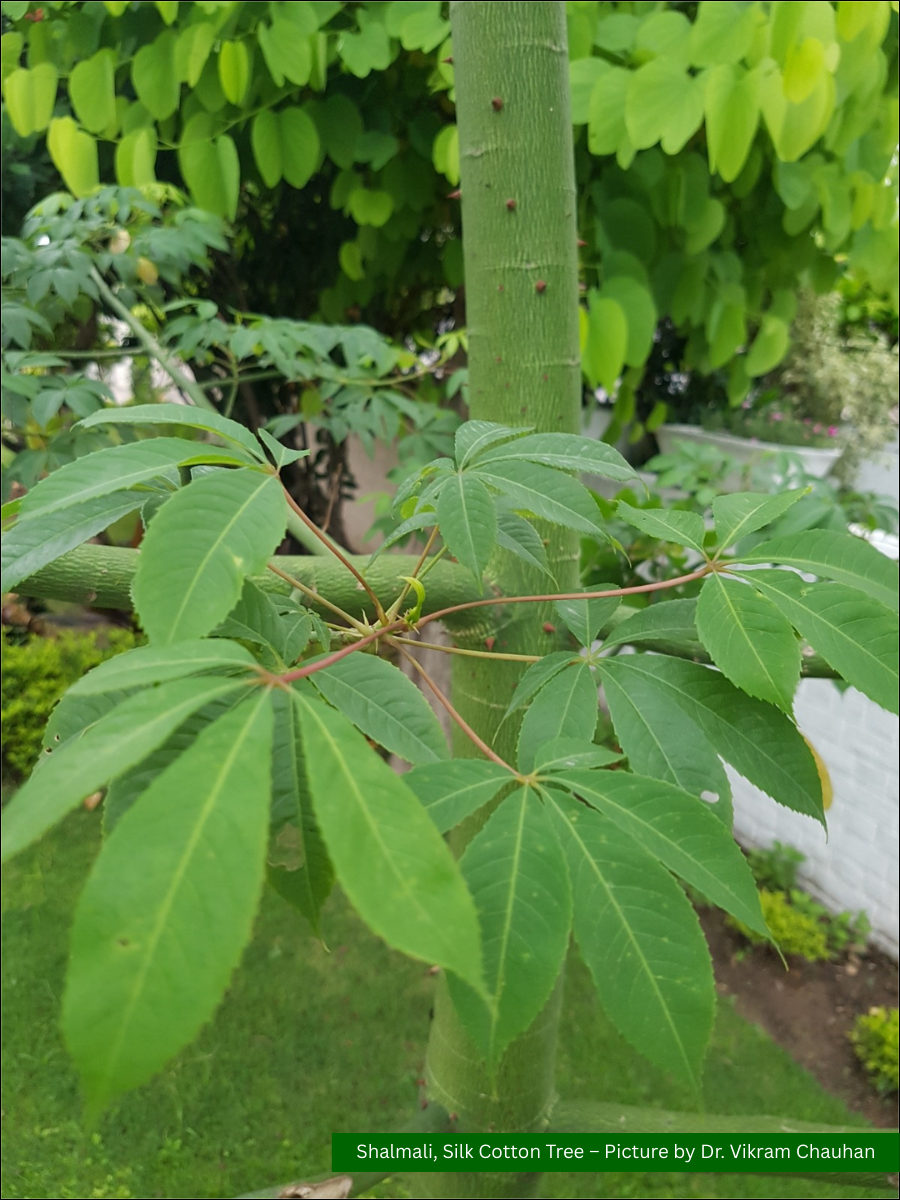
Habitat
Shalmali is mainly native to India, Burma. In India this plant grows throughout hotter areas up to altitudes of 1500mts. It is very common in deciduous forests, near rivers and also cultivated in gardens and roadsides in peninsular regions of India. It is also found in tropical southern Asia, Australia and Africa. It is also wildly distributed in Malaysia and Hong Kong.
Classification
- Kingdom – Plantae
- Order – Malvales
- Family – Bombacaceae
Names
- Latin name – Salmalia Malabarica
- Common name – Silk cotton tree, Kapok tree
- Sanskrit name – Kantakadya, Picchila, Mocha, Raktapushpa, Sthirayu
- Hindi name – Shalmali, Semal
- Bengali name – Semul
- Assamese name – Simolu
- Gujarati name – Shimalo
- Telugu name – Buruga
- Tamil name – Sittan, Sanmali, Llavam
- Kannada name – Buruga
- Marathi name – Safetasarava
- Urdu name – Sumbal
- Malayalam name – Unnamurika
- Manipuri name – Tera
- Sinhala name – Katulmbul
- Vietnamese name – Hoagao
- Greek name – Vomvax malvarikos
- Portuguese name – Painiera-vermehla-da
Ayurvedic properties
| Hindi / Sanskrit | English | ||
| Rasa | Kashay | Taste | Astringent |
| Guna | Laghu, Snigdha | Physical Property | Light, Unctuous |
| Virya | Sheet | Potency | Cold |
| Vipaka | Madhura | Metabolic Property (After Digestion) | Sweet |
Effects on Doshas
It balances pitta and vata doshas.
| Charak Samhita | Sushrut Samhita |
|
|
Ancient verse about Salmalia Malabarica

The Bhavprakash nighantu Twenty Eighth edition of 2010: verse 54-55, page no-525.
Above shalok states that shalmali, mocha, picchila, purani, raktpushpa, sthirayu, kantkadya and tulini are various synonyms of salmalia. This herb has sweet taste after digestion with cold potency. In Ayurveda it is used as rasayan and it used in pacification of vata and pitta dosha. This herb is used to cure hemorrhoids and bleeding disorders.
Reference
- The Bhavprakash nighantu with elaborated Hindi commentary by Padmashri prof. K.C. Chunekar, edited by Late Dr. G.S. Pandey: Twenty Eighth edition of 2010: gudchayadi varga; verse 54-55, page no-525.
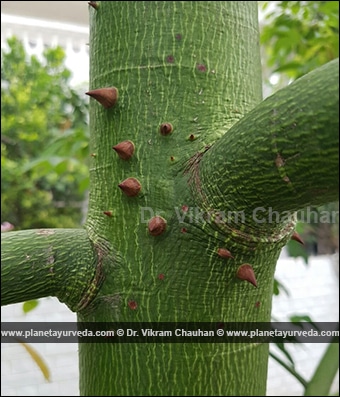
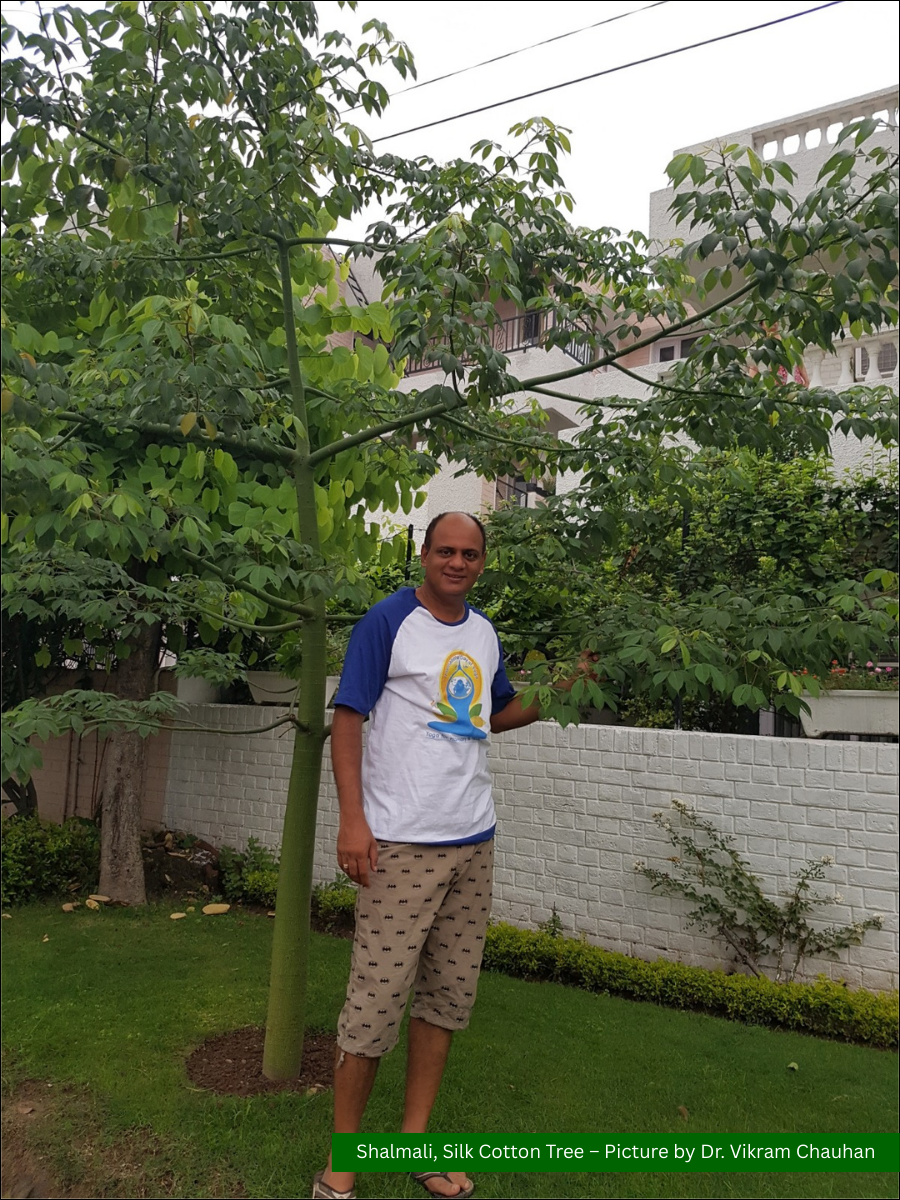
Practical uses of Salmalia Malabarica
- Roots of salmalia are used for treating dysentery, diarrhea, and menorrhagia,are styptic and also useful for treating wounds.
- Gum of this plant is used to reduce burning sensation and also effective for treating dysentery, hemoptysis, influenza, pulmonary tuberculosis and enteritis.
- Bark of this tree is used to stop bleeding and also beneficial for healing of wounds.
- Astringent flowers are used in treatment of piles and hemorrhoids and also good for various types of skin troubles. Paste of seeds is used to restore color of skin.
- Paste of thorns of the stem bark is applied externally as paste to cure pimples and acne.
- Seeds are used for treating chronic cystitis and gonorrhea.
- Mature fruits of the plant are used in the treatment of ulceration of kidney and bladder. It is also used to reduce chronic inflammation and calculi related disorders.
- This herb is very beneficial for the male reproductive system. It is used to improve both quantity and quality of semen. It is very beneficial for the sufferers of nocturnal emission.
- Flowers are laxative, diuretic and very beneficial for skin disorders. Flowers are also used to cure splenomegaly, conjunctivitis and hemorrhage.
- It is used to pacify pitta and vatadosha.
Planet Ayurveda Products with from Shalmali / Silk Cotton Tree / Salmalia malabarica
Part used
- Seeds
- Leaves
- Fruits
- Roots
- Flowers
- Gum (mocharas)
- Thorns
Dosage
- Root powder – 6-12gm
- Infusion of flower – 12-20gm
- Gum -1-3gm
- Fruit powder -1-3gm



